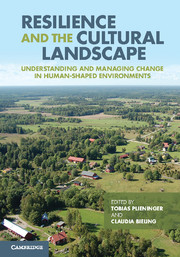 Resilience and the Cultural Landscape
Resilience and the Cultural Landscape Preface
Published online by Cambridge University Press: 05 November 2012
Summary
Preface
We are living in an era in which human action has developed to be the main driver of global environmental change – the geological epoch of the anthropocene. One-third of terrestrial net primary production is now consumed by humans, and the material equivalent of about one and a half planets is claimed to support human activities. Planetary boundaries to irreversible climate change, biodiversity loss and changes to the global nitrogen cycle have already been transgressed. The terrestrial biosphere has been fundamentally restructured for agriculture and forestry, so that more than four-fifths of the Earth’s land surface is now human dominated.
The overall harmful consequences of humanity’s influence on global ecosystems in past decades are beyond doubt. However, the prevailing view on human–environment relationships is often overgeneralised. The conceptual framework of the Millennium Ecosystem Assessment exemplifies an understanding of humans that degrade ecosystems, while their well-being critically depends on a sustained delivery of ecosystem services. As true as this perspective is, reducing humans to degrading agents and/or consumers of ecosystem services loses sight of the myriads of cases throughout the world in which land use systems and practices have shaped valued cultural landscapes, which effectively integrate ecology, economics and cultural needs. Fortunately, the idea of cultural landscapes has recently gained ground in science, policy and land use practice. For example, the notion entered the circles around the Convention on Biological Diversity, which now acknowledges that people have developed and sustainably managed outstanding landscapes over a long period. Examples for cultural landscapes that enhance both biodiversity and human well-being include the rice terrace landscapes of the Philippines, extensively used mountain grasslands in the European Alps and the dehesa agroforestry landscapes on the Iberian Peninsula.
- Type
- Chapter
- Information
- Resilience and the Cultural LandscapeUnderstanding and Managing Change in Human-Shaped Environments, pp. xiii - xviPublisher: Cambridge University PressPrint publication year: 2012


